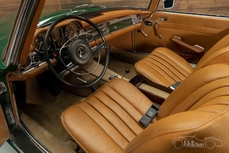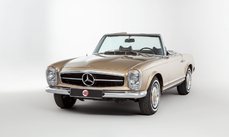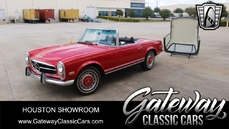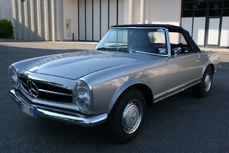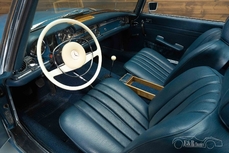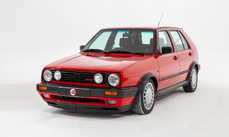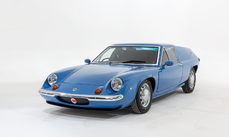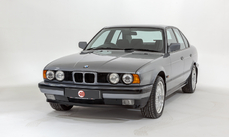Mercedes-Benz 280SL w113 Pagoda 1970
General description :
Model History
The Mercedes-Benz W113 SL was a two-seat roadster produced from 1963 to 1971. It was introduced at the 1963 Geneva Motor Show and replaced both the legendary 300SL (W198) and the 190SL (W121). The model is well known for its distinctive, patented, and slightly concave hardtop, which inspired the "Pagoda" nickname.
All W113 SL models were equipped with a straight-six cylinder engine with multi-port fuel injection. The bonnet, boot lid, door skins, and tonneau cover were made of aluminium to reduce weight. The comparatively short and wide chassis, combined with an excellent suspension, powerful brakes, and radial tires gave the W113 superb handling for its time. The styling of the front, with its characteristic upright Bosch "fishbowl" headlights and simple chrome grille, dominated by the large three-pointed star, paid homage to the already legendary 300SL roadster.
The 280SL was introduced in December 1967 and continued in production until 23rd February 1971, when the W113 was replaced by its successor, the R107. Over the years, the W113 evolved from a sports car into a comfortable grand tourer, and US models were by then usually equipped with the 4-speed automatic transmission and air conditioning. Manual transmission models came with the standard 4-speed or the optional ZF 5-speed. Of the 23,885 280SLs produced, more than half were sold in the US.
The main change throughout production was an upgrade to the 2778cc M130 engine. The performance improvement was achieved by increasing bore by 4.5mm, which stretched the limits of the M180 block, and required pairwise cylinder casts without cooling water passages. This mandated an oil-cooler, which was fitted vertically next to the radiator. Each engine was now bench-tested for two hours prior to being fitted, so their power specification was guaranteed to last.
Equipment
Tunis Beige Metallic paintwork (462), Black MB Tex upholstery (131), Removable hardtop in black, Folding soft-top, Four-speed automatic transmission, Becker Europa radio, Lap seat belts, Illuminated and lockable glove compartment, Dash clock, MPH speedo, Original boot mat, Bumper overriders, Spare wheel with cover.
Exterior
The gleaming Tunis Beige paintwork presents really well throughout with few blemishes to report. Both sides of the car are perfectly straight with even panel gaps and a resplendent metallic shine. All the brightwork appears in fantastic condition and is for the most part original, with a lovely mirror finish to be found on close inspection; the same is true of the lights – all crystal clear and moisture-free. The removable hardtop looks superb in contrasting black and the folding soft-top presents well with no damage to the rear window.
Interior
The interior space is pleasingly original, the black MB Tex seats really having stood the test of time. The upholstery is in great condition and there are no rips in the multi-loop carpets, with only a small amount of fading along the transmission tunnel and rear section to report; we have just replaced the footwell mats with factory-correct items from Germany. Other commonly worn areas, such as the steering wheel and dash, show few signs of use. As a California-supplied car this example is equipped with a dealer-fit air conditioning unit. The hardtop headlining is in excellent condition.
ENGINE & TRANSMISSION
The original 2.8-litre straight six is in fine mechanical fettle having been well maintained over the course of its life. The service booklet contains 9 entries from its time in the US and there is documentation for another 18 services carried out since then. We have just had the car fully inspected, serviced and MOT’d for the new keeper’s piece of mind. It performs beautifully on test with a lovely straight six purr and near-seamless gear changes from the four-speed auto ‘box.
WHEELS, TYRES & BRAKES
The Pagoda sits on 15-inch steels with the correct polished hubcaps. The wheel trims present in good original condition with only some curb marking to be found on close inspection. The wheels are shod in a matching set of period Michelin whitewall tyres, each with ample tread remaining.
History File
This matching-numbers 280SL Pagoda was first registered in California in April 1970. It remained with the same keeper for the next twenty years before being exported to Japan in 1990 at 94k miles. The car resided on Japan’s salt-free roads up until 2019 when it was imported into the UK by 4 Star at 105k miles. Since arriving in the country we have had it fully inspected, serviced and MOT’d; a brand new exhaust system has also just been fitted. The paperwork is complete with the original maintenance booklet containing 9 US entries, along with documentation and invoices for a further 18 services. The factory data card and a Date of Manufacture letter from Mercedes are also present.
http://www.4starclassics.com/for-sale/mercedes-280sl-pagoda-for-sale-2/
1970 Mercedes-Benz 280SL w113 Pagoda is listed sold on ClassicDigest in Kingsley by 4 Star Classics for £74995.
Car Facts
Car type : Car Make : Mercedes-Benz Model : 280SL w113 Model Version : Pagoda Engine size : 2.8 Model Year : 1970 Sub type : Convertible Location : Hampshire
Sold
Seller Information
Sold
People who viewed this Mercedes-Benz 280SL w113 also viewed similar Mercedes-Benz listed at ClassicDigest
Other cars listed for sale by this dealer
About Mercedes-Benz
In the annals of automotive history, the journey of Mercedes-Benz is a tale that unfolds with the ingenuity of its founding pioneers. In the year 1886, Karl Benz crafted the Benz Patent Motorwagen, a creation that would go down in history as the world's inaugural automobile. Unbeknownst to him, this moment marked the genesis of what would evolve into the most illustrious premium car manufacturer globally. The financial underpinning of this pioneering venture, interestingly, was provided by Karl Benz's wife, Bertha Benz, demonstrating a remarkable partnership that would set the tone for Mercedes-Benz's legacy.A parallel narrative emerged not far away, as Daimler-Motoren-Gesellschaft, founded by Gottlieb Daimler and Wilhelm Maybach, entered the scene. In 1901, they unveiled their automobile under the now-famous moniker "Mercedes," meaning "godsend" in Spanish. This name was bestowed upon the car at the behest of Emil Jellinek's daughter, the distributor for Daimler-Motoren-Gesellschaft. The wheels of innovation were set in motion.
Fast forward to 1926, a pivotal year that witnessed the merger of Daimler with Benz & Cie., culminating in the birth of Daimler-Benz. The amalgamation saw the adoption of "Mercedes-Benz" as the distinguished trademark for their automobiles, fusing the legacies of two visionary entities into one.
Contrary to perceptions of conservatism, the trajectory of Daimler-Benz unfolds as a chronicle of industry firsts. From the introduction of the honeycomb radiator to the float carburetor, and the pioneering implementation of four-wheel brakes in 1924, Daimler-Benz consistently pushed the boundaries of automotive innovation. The diesel-powered Mercedes-Benz 260 D in 1936 marked the inception of diesel engines in passenger cars. The iconic Mercedes-Benz 300SL Gullwing made history as the first car with direct fuel injection, albeit the Gutbrod's tiny 2-stroke engine can claim precedence.
Safety innovations became a hallmark, with Béla Barényi's patented safety cell design in the "Ponton"-models in 1951, featuring front and rear crumple zones. The W116 450SEL 6.9 saw the introduction of the Anti-Lock Brake system (ABS), another pioneering safety feature. From the first production airbags and beyond, the legacy of "firsts" continued to be etched into the fabric of Daimler-Benz.
Over its centennial journey, Mercedes-Benz has not merely produced cars but has sculpted automotive icons. The SSKL, 710 SSK Trossi Roadster, 770K Grosser, 540K Spezial Roadster, 300SL Gullwing, w100 600 Pullman, w111 280SE 3.5 Flachkühler, w113 230SL Pagoda, w109 300 SEL 6.3, and w201 2.3-16 Cosworth stand testament to the brand's commitment to engineering excellence.
The roaring Silver Arrows, or "Silberpfeile," including the W 25, W 125, W154, W165, and W196, created a legacy of dominance on the racetrack. These machines were not merely cars; they were expressions of precision, speed, and an indomitable spirit that left their competitors in the dust.
As Mercedes-Benz marches into the future, it does so not just as an automaker but as a custodian of a legacy, a torchbearer of innovation, and a beacon of automotive excellence. The road ahead is sure to witness the continued fusion of cutting-edge technology, timeless design, and an unwavering commitment to setting new standards in the world of automobiles.
One luminary figure who left an indelible mark was Béla Barényi, often heralded as the "father of passive safety" for his pioneering work in safety engineering. His patented safety cell design, featuring front and rear crumple zones, became a hallmark of Mercedes-Benz's commitment to occupant safety, setting new standards that reverberated throughout the automotive world.
Moving through the chronicles, the collaborative genius of Wilhelm Maybach, alongside Gottlieb Daimler, laid the foundation for Daimler-Motoren-Gesellschaft. Their innovations not only birthed the first Mercedes but established a culture of relentless pursuit of technological excellence that remains integral to Mercedes-Benz's DNA.
In the post-merger era of 1926, Ferdinand Porsche emerged as a prominent figure within Mercedes-Benz. His work on the Mercedes-Benz S-Type, a supercharged race car, garnered acclaim and set the stage for a legacy that extended far beyond the marque. Porsche's impact would later extend to his eponymous company, but his influence at Mercedes-Benz during those formative years was pivotal.
As the 20th century progressed, the legendary Rudolf Uhlenhaut emerged as a key figure. Uhlenhaut, an accomplished engineer and the driving force behind the iconic Silver Arrows, played a crucial role in Mercedes-Benz's dominance in motorsports. His engineering prowess and attention to detail were instrumental in creating some of the most formidable racing cars of the era.
In the latter half of the century, figures like Bruno Sacco, the head of design at Mercedes-Benz from 1975 to 1999, left an indelible imprint on the brand's aesthetic identity. Sacco's design philosophy, characterized by clean lines and timeless elegance, shaped iconic models like the W126 S-Class and the W201 190E, solidifying Mercedes-Benz's reputation for luxury and sophistication.
The narrative would be incomplete without acknowledging the contributions of engineers like Hans Scherenberg, whose leadership in the 1970s ushered in a new era of technological innovation at Mercedes-Benz. Scherenberg's tenure saw the development of groundbreaking technologies, including the Anti-Lock Brake system (ABS) and the introduction of airbags in production cars.


